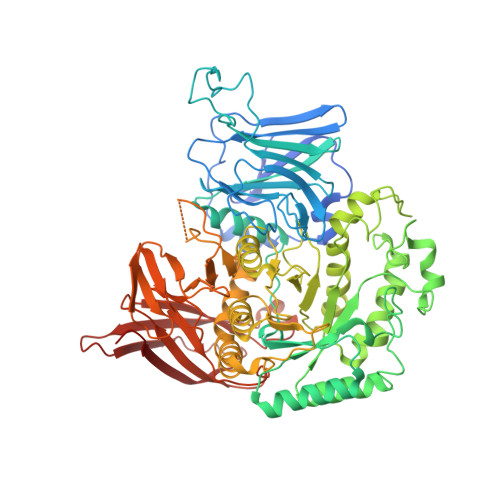Structural and biochemical characterization of novel bacterial alpha-galactosidases belonging to glycoside hydrolase family 31
Miyazaki, T., Ishizaki, Y., Ichikawa, M., Nishikawa, A., Tonozuka, T.(2015) Biochem J 469: 145-158
- PubMed: 25942325
- DOI: https://doi.org/10.1042/BJ20150261
- Primary Citation of Related Structures:
4XPO, 4XPP, 4XPQ, 4XPR, 4XPS - PubMed Abstract:
Glycoside hydrolase family 31 (GH31) proteins have been reportedly identified as exo-α-glycosidases with activity for α-glucosides and α-xylosides. We focused on a GH31 subfamily, which contains proteins with low sequence identity (<24%) to the previously reported GH31 glycosidases and characterized two enzymes from Pedobacter heparinus and Pedobacter saltans. The enzymes unexpectedly exhibited α-galactosidase activity, but were not active on α-glucosides and α-xylosides. The crystal structures of one of the enzymes, PsGal31A, in unliganded form and in complexes with D-galactose or L-fucose and the catalytic nucleophile mutant in unliganded form and in complex with p-nitrophenyl-α-D-galactopyranoside, were determined at 1.85-2.30 Å (1 Å=0.1 nm) resolution. The overall structure of PsGal31A contains four domains and the catalytic domain adopts a (β/α)8-barrel fold that resembles the structures of other GH31 enzymes. Two catalytic aspartic acid residues are structurally conserved in the enzymes, whereas most residues forming the active site differ from those of GH31 α-glucosidases and α-xylosidases. PsGal31A forms a dimer via a unique loop that is not conserved in other reported GH31 enzymes; this loop is involved in its aglycone specificity and in binding L-fucose. Considering potential genes for α-L-fucosidases and carbohydrate-related proteins within the vicinity of Pedobacter Gal31, the identified Gal31 enzymes are likely to function in a novel sugar degradation system. This is the first report of α-galactosidases which belong to GH31 family.
- Department of Applied Biological Science, Tokyo University of Agriculture and Technology, 3-5-8 Saiwai-cho, Fuchu, Tokyo 183-8509, Japan.
Organizational Affiliation:



















